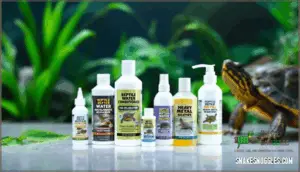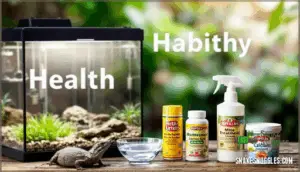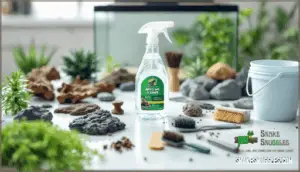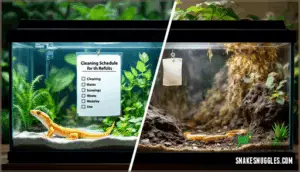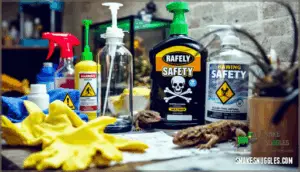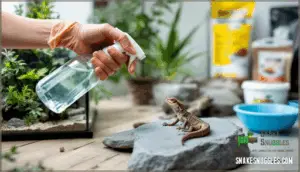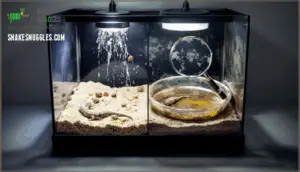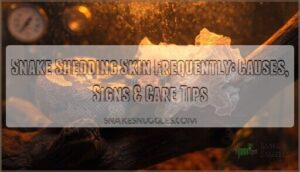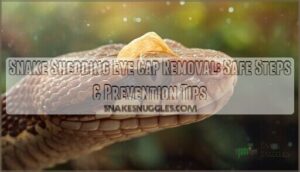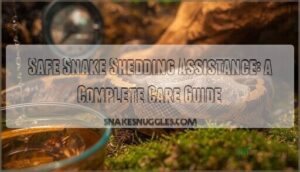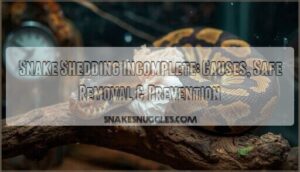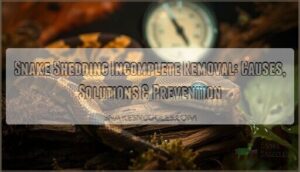This site is supported by our readers. We may earn a commission, at no cost to you, if you purchase through links.
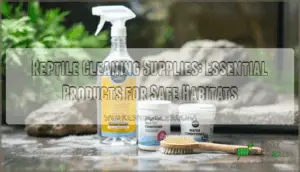
Reptile cleaning supplies exist precisely because standard products leave invisible threats that cold-blooded animals can’t metabolize. From enzyme formulas that digest organic waste without toxic fumes to water conditioners that neutralize chloramine before it burns delicate lung tissue, the right tools transform routine maintenance into a shield against the most common killers in captivity.
Table Of Contents
Key Takeaways
- Tap water contains chlorine, chloramines, and heavy metals that can harm reptiles through direct contact or ingestion, making water conditioners and dechlorinators essential for removing these toxins before use in habitats or drinking bowls.
- Household cleaners leave toxic residues that reptiles absorb through their skin, requiring veterinary-grade disinfectants like chlorhexidine or diluted bleach followed by thorough rinsing and complete drying to prevent organ failure.
- Daily spot cleaning combined with monthly deep disinfection prevents bacterial blooms and parasite cycles, while proper substrate replacement every 1-3 months eliminates accumulated waste that standard cleaning can’t address.
- Mixing cleaning chemicals like bleach and ammonia creates lethal chloramine gas, and inadequate rinsing leaves biocide residues on surfaces that poison reptiles through continuous skin contact in their enclosed environments.
Essential Reptile Cleaning Supplies
You can’t keep your reptile healthy without the right cleaning gear. A clean habitat prevents disease, removes harmful waste, and creates a safe environment for your pet.
The following supplies cover everything you need to maintain a spotless terrarium or tank.
Terrarium and Tank Cleaners
Keeping a glass box spotless isn’t just about good looks—it’s the frontline defense against bacteria, mold, and parasites that can sicken your reptile. Quality terrarium cleaners cut through grime without leaving harmful residue. You’ll want products designed for cage cleaning that work on glass, plastic, and decorations:
- Enzyme cleaners break down organic waste naturally
- Odor removal formulas neutralize smells at the source
- Natural cleaners offer safe substrate cleaning without toxic fumes
Choose reptile cleaning supplies that rinse clean and dry fast.
Disinfectants and Safe Cleaning Agents
After basic cleaning, you need veterinary disinfectants for reptiles that kill pathogens without harming your pet. Nolvasan (chlorhexidine), diluted bleach (1/2 cup per gallon), and quaternary ammonium compounds are safe disinfectants when properly rinsed. Never mix chemicals—bleach and ammonia create toxic fumes. Povidone-iodine works but poses amphibian safety risks in sensitive species.
Residue risks are real: plastics trap chemicals, so proper rinsing is non-negotiable. A safe reptile environment depends on thorough drying before your animal returns.
For routine cleaning, white vinegar is an effective and safe option. Good reptile hygiene and terrarium cleaner habits prevent disease while protecting your scaly companion.
Scrapers, Brushes, and Cleaning Tools
Once your disinfectant has done its job and dried completely, you’ll need the right scraping and brushing tools to tackle stubborn waste, calcium deposits, and dried-on debris that cleaners alone won’t remove. Redline Science blade scrapers excel at removing algae from glass surfaces without scratching, while soft-bristle brushes reach tight corners. Use stiff-bristle material for substrate sifting and removing calcium buildup.
Always sterilize your terrarium cleaning tools between uses to prevent cross-contamination. These reptile cleaning supplies are essential tank cleaners that make thorough habitat maintenance possible.
Spray Bottles and Refill Solutions
Having the right spray bottles on hand lets you apply your disinfectants evenly and efficiently without wasting product or creating unsafe puddles in the enclosure. Look for adjustable nozzle spray patterns that switch between fine mist and stream settings.
32 oz spray bottles with disinfectant ($7.99) and disinfectant refills ($4.99) offer economical solutions. Check refill concentration levels for proper dilution, and verify disinfectant compatibility with your bottle material to prevent chemical degradation.
All-in-One Terrarium Cleaning Kits
Terrarium cleaning kits ($9.99) bundle the essentials—scrapers, brushes, disinfectant, and sometimes even a small spray bottle—so you’re not scrambling to gather tools each time you need to scrub down your gecko’s glass or rinse out your turtle’s basking platform. These kits work well for beginners who want everything in one package.
User reviews generally praise the convenience, though you can create DIY alternatives by purchasing individual terrarium maintenance supplies if you prefer specialized cleaning and disinfecting supplies.
Water Treatment Products for Reptiles
Water is more than just something your reptile drinks—it’s a habitat element that demands attention. Tap water contains chlorine, chloramines, and heavy metals that can harm your pet, so you’ll need the right treatment products to make it safe.
Let’s look at the key water treatment options that keep your reptile’s aquatic environment healthy and toxin-free.
Water Conditioners and Dechlorinators
Tap water often contains chlorine and chloramine that can stress or harm your reptile, making a tap water conditioner essential for safe hydration. Premium reptile water conditioners neutralize these chemicals within minutes while restoring electrolyte balance and supporting species sensitivity needs. Providing reptiles with chlorine-free water can promote their overall well-being.
Key benefits of reptile water treatment products:
- Chloramine removal – Most municipal water contains stable chloramine that won’t evaporate, requiring chemical neutralization.
- Rapid chlorine removal – Dechlorinators work in minutes using 2–4 drops per gallon.
- Dosing automation – Smart dispensers guarantee accurate treatment without guesswork.
- Conditioner alternatives – Reverse osmosis systems provide chemical-free options, though conditioners add beneficial minerals.
Products like Reptisafe offer broad-spectrum safety for diverse species.
Water Quality Test Kits
Testing your water isn’t just a precaution—it’s your early warning system for detecting invisible threats that could compromise your reptile’s health before symptoms appear.
Multi-parameter test strips let you monitor pH, ammonia, and nitrite levels weekly, catching problem indicators tied to your water source or filtration breakdown.
Kit accuracy matters for reptile habitat stability, making water quality testing as essential as any water conditioner in your reptile cleaning supplies arsenal.
Algae Control and Filtration Solutions
Too much algae in a reptile tank isn’t just ugly—it’s an open invitation for cloudy water and health risks. You’ll tackle algae best with a mix of UV sterilization, regular water changes, proper mechanical filtration, and clever biological methods.
Add reliable algae control solutions and aquarium filtration to help balance water quality, so your reptiles thrive.
Saltwater and Freshwater Treatment Options
You wouldn’t pour the same liquid into a goldfish bowl and a saltwater reef tank, and your reptile’s water deserves that same level of attention. Match your water conditioner to your aquatic environment with these essentials for reptile care:
- Salinity levels adjusted for brackish turtles or marine species
- pH stability products preventing dangerous swings
- Mineral balance formulas supporting shell and bone health
- Beneficial bacteria starters accelerating water cycling
- Saltwater treatment options for coastal reptile cleaning needs
Health and Hygiene Solutions for Reptiles
Keeping your reptile healthy goes beyond regular cage cleaning. You’ll also need specialized products that address common health concerns, from parasites to skin issues.
Let’s look at the key health and hygiene solutions that help your pet stay in top condition.
Natural Dewormers and Parasite Control
Parasites pose a significant threat to captive reptiles, with studies revealing infection rates as high as 83% in certain populations. Juveniles are particularly susceptible. While products like Natural Reptile Dewormer offer a parasite cleanse approach to combat intestinal worm buildup, substantial evidence gaps persist.
In laboratory settings, herbal remedies have shown promise. For instance, wormwood extracts can immobilize parasites, and specific plant compounds have reduced worm counts by up to 67%. However, veterinary guidelines do not currently endorse these as standalone treatments. The growing concern over resistance to chemical dewormers has sparked interest in alternative methods for reptile parasite control. Despite this, dosage safety remains largely unstudied for most reptile species.
Preventative measures, such as thorough habitat cleaning, are more reliable in reducing reinfection risks compared to unproven reptile health products.
| Natural Dewormer Type | Current Evidence Status |
|---|---|
| Wormwood extracts | Lab efficacy shown; reptile safety unconfirmed |
| Diatomaceous earth | Minimal egg impact; variable results |
| Commercial herbal blends | Livestock trials show no significant reduction |
| Condensed tannins | Inhibits larvae in vitro; dosing unknown |
Wound Care and Antiseptic Sprays
Injuries in captive reptiles—from substrate abrasions to aggressive tankmate encounters—require prompt attention to prevent bacterial infections that can quickly escalate into systemic illness.
Reptile wound care products, like antiseptic irrigation sprays with antibacterial properties, help with infection prevention through safe topical application. Look for veterinary disinfectant formulas with safe ingredients that promote healing without toxic residues.
Spray alternatives to povidone-iodine work well for minor wounds, though severe cases need professional evaluation alongside any Reptile Recovery protocol.
Shedding Aids and Skin Conditioners
When shedding stalls or becomes incomplete, your reptile’s skin doesn’t just look dull—it can trap bacteria, restrict circulation, and signal underlying hydration or environmental problems.
Natural shedding solutions with moisturizing ingredients address shedding issues by improving skin hydration and scale health when proper humidity alone isn’t enough.
Shedding frequency varies by species, but conditioning sprays help guarantee complete molts without leftover patches that invite infection.
Turtle Shell Conditioners and Shine Products
Turtle and tortoise shells require dedicated conditioning just like skin, because these keratinized plates can dry out, crack, or develop fungal blooms when water quality and basking conditions aren’t ideal. Shell conditioners with antifungal protection moisturize keratin layers while preventing opportunistic infections that thrive in damp environments.
Quality products for turtle shell care provide:
- Deep hydration that penetrates scutes without leaving greasy residues
- Antifungal protection against shell rot and microbial colonization
- Shell revitalization that restores natural luster to dull or damaged plates
- Shine enhancement indicating healthy keratin structure and proper mineralization
- Safe application techniques using soft cloths on completely dry shells
Regular conditioning promotes long-term pet health and structural integrity.
Nutritional and Recovery Supplements
Sick or stressed reptiles won’t recover on their own—they need targeted nutritional support to rebuild strength and stabilize essential functions when illness or injury disrupts their natural eating patterns.
Reptile Recovery products and nutritional supplements for reptiles combine Appetite Stimulation with digestible nutrients, while Reptile Electrolytes deliver Hydration Support and Mineral Supplementation that accelerate healing.
These vitamins and supplements restore Vitamin Absorption and pet health through Boosting Immunity when your animal needs it most.
How to Clean and Maintain Reptile Habitats
Keeping your reptile’s habitat clean doesn’t have to be complicated, but it does require consistency and the right approach. A clean enclosure prevents disease, reduces stress, and helps your pet thrive in a space that mimics its natural environment.
Here’s what you need to know about maintaining a healthy habitat through proper cleaning routines, safe chemical use, and disease prevention.
Step-by-Step Terrarium Cleaning Process
Cleaning a terrarium properly isn’t just about wiping down glass—it’s a methodical process that protects your reptile’s health while maintaining a habitat they’ll thrive in.
Start with waste removal using a scoop, then spot-clean substrate daily.
For deeper terrarium maintenance, remove decor for separate disinfecting surfaces with reptile-safe cleaning products. Rinse everything thoroughly, perform a final inspection before reassembly, and your reptile tank maintenance routine is complete.
Cleaning Frequency and Schedules
How often you clean your reptile’s habitat depends on the species, enclosure size, and how messy your scaly companion happens to be—but sticking to a consistent schedule is the key to preventing disease. Spot cleaning should happen daily to remove waste and uneaten food, while deep cleaning with disinfectants happens monthly for most setups.
Substrate changes vary by type—paper gets swapped weekly, while bioactive systems need minimal intervention.
Adjust your terrarium maintenance routine seasonally when activity levels shift, and always increase reptile cage maintenance during quarantine schedules to contain potential pathogens.
Safe Handling of Cleaning Chemicals
Mishandling disinfectants can turn a routine cleaning session into a genuine health risk for both you and your reptile, so understanding proper chemical safety isn’t just smart—it’s essential.
Always wear gloves and eye protection when working with disinfectant solutions, and guarantee proper ventilation to avoid inhaling toxic fumes from bleach or quaternary ammonium compounds.
Follow dilution guidelines exactly—too strong concentrations leave harmful residue, while weak mixtures won’t kill pathogens.
Store all pesticides and cleaning chemicals in labeled containers away from your reptile’s habitat, and rinse every surface thoroughly with safe water before reintroducing your pet.
Preventing Disease and Contamination
Routine disinfection using reptile cleaning supplies acts like a shield against invisible threats that can harm both you and your animals. Proper biosecurity protocols reduce transmission of zoonotic diseases, such as salmonellosis, which affects thousands of reptile owners annually.
Follow these critical steps for effective terrarium cleaning and contamination control:
- Implement quarantine procedures for new reptiles (30–60 days minimum) before introducing them to existing collections
- Practice substrate sanitation by removing waste daily and replacing substrate every 2–4 weeks
- Use appropriate disinfectant solutions (chlorhexidine or diluted bleach) with thorough rinsing to eliminate antimicrobial residues
- Establish dedicated hygiene protocols including handwashing after touching and separate cleaning tools per enclosure
- Dispose of waste properly in sealed bags away from food preparation areas to prevent cross-contamination
Safety Tips and Common Cleaning Mistakes
Cleaning your reptile’s habitat requires care and attention to avoid common pitfalls that can harm your pet. Even products labeled "safe" can pose risks if you don’t use them correctly or rinse them thoroughly.
Let’s walk through the key safety guidelines and mistakes you’ll want to steer clear of to keep your reptile healthy and thriving.
Toxic Cleaners and Residue Risks
Many household cleaners contain ammonia toxicity risks and bleach exposure dangers that can seriously harm your reptile. Toxic chemicals like these produce fumes that irritate respiratory systems, even in small amounts.
Harmful chemicals and pesticides leave behind residue persistence on surfaces for hours or days, which your reptile absorbs through skin contact. Regulatory gaps mean most cleaners lack reptile-specific safety testing.
That’s why safer alternatives like F10SC or chlorhexidine matter so much.
Proper Rinsing and Drying Methods
Even the safest disinfectant becomes a hazard if you don’t rinse and dry your reptile’s enclosure thoroughly. Residue removal requires multiple rinses with hot water, especially on plastic surfaces where cleaning supplies cling stubbornly.
After thorough rinsing, let everything air-dry completely with good ventilation—damp terrarium maintenance invites mold and bacterial growth that undermine your reptile tank cleaning efforts.
Safe Use of Disinfectants Around Reptiles
You wouldn’t leave a bottle of bleach open near your child’s play area, so applying that same protective instinct to disinfectant use around your reptile makes perfect sense. Safe dilutions and proper rinsing protect against disinfectant toxicity, which varies by species sensitivity.
Critical antimicrobial safety practices for terrarium cleaning:
- Always remove your reptile before applying any disinfectant to prevent respiratory or skin exposure
- Follow manufacturer dilution ratios exactly—stronger isn’t safer for reptile cleaning supplies
- Ventilate the space thoroughly during and after disinfectant application
- Test a small surface first to check for residue dangers on porous decorations
- Use safe water for final rinses to eliminate all antimicrobial traces before reintroducing your pet
What to Avoid During Habitat Cleaning
Knowing what to use is only half the battle—understanding what to skip can prevent some of the most common (and avoidable) health risks in your reptile’s home. Never mix bleach with ammonia-based cleaners, as this produces toxic chloramines that can severely harm respiratory systems. Avoid abrasive cleaners that scratch surfaces, creating bacterial hideouts.
| Common Mistake | Why It’s Dangerous |
|---|---|
| Ammonia Mixtures | Creates toxic chlorine gas when combined with bleach |
| Inadequate Rinsing | Leaves biocide residues that poison through skin contact |
| Cross-Contamination | Spreads harmful bacteria between enclosures and animals |
Frequently Asked Questions (FAQs)
How often should I replace reptile substrate?
Substrate lifespan varies by reptile species, enclosure size, and waste buildup. Replace spot-cleaned substrate every 1-3 months for most reptiles.
Watch for mold growth or odors requiring immediate replacement during routine terrarium cleaning.
Can I use household cleaners for reptiles?
Most household cleaners contain toxic chemicals that pose serious residue dangers to reptiles. Their skin sensitivity makes even diluted products risky.
Instead, stick with reptile-specific disinfectants and terrarium cleaning supplies designed for safe cage cleaner use without harmful residues.
Whats the best temperature for cleaning solutions?
Like a chef knows hot water cuts grease best, warm cleaning solutions work better. Ideal temperature ranges from lukewarm to slightly warm—around 75-85°F—which boosts solution effectiveness while protecting reptile sensitivity.
Hot water risks chemical fumes and habitat damage, compromising cleaning safety.
How do I deep clean decorations safely?
Decoration material and porosity concerns matter when deep cleaning.
Soak non-porous items in a safe disinfectant like diluted bleach or Nolvasan for ten minutes, scrub thoroughly, then rinse multiple times to guarantee complete residue removal and allow thorough drying before reintroducing them.
Should I quarantine new reptiles before cleaning?
Quarantine benefits go beyond disease prevention—they’re about protecting your entire collection from cross-contamination risks.
Stress reduction during this period helps new arrivals adjust before you introduce reptile cleaning supplies into their routine, safeguarding both the newcomer and your established reptile habitat cleaning practices.
Conclusion
Think of your terrarium as a garden where invisible threats bloom faster than you can see. The right reptile cleaning supplies don’t just remove visible waste—they dismantle the pathogen cycles that thrive in warm, humid microclimates.
Every enzyme spray, every chloramine-neutralizing drop, every properly rinsed surface becomes a barrier between your animal and preventable illness.
Master these tools, and you’ll transform cleaning from a dreaded chore into the most powerful act of protection you perform each week.
- https://www.businesswire.com/news/home/20200513005335/en/Sale-of-Reptile-Products-Forecast-to-Grow-from-$495-million-in-2019-to-Reach-Between-$550-million-and-$650-million-by-2024-COVID-19-Adjusted-Forecasts---ResearchAndMarkets.com
- https://www.zenhabitats.com/blogs/reptile-care-sheets-resources/reptile-safe-disinfectant-cleaners
- https://www.reptilecentre.com/blogs/reptile-blog/why-all-reptiles-keepers-should-use-f10-disinfectant
- https://talis-us.com/blogs/blog-47/top-choices-for-best-substrates-for-reptiles-explained
- https://community.morphmarket.com/t/i-m-seeing-a-lot-of-conflicting-info-what-s-a-good-enclosure-cleaning-schedule/43532

